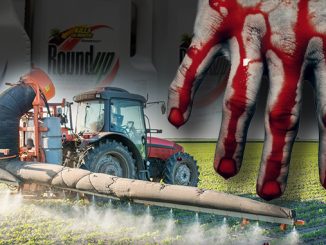
Farmers in India are rejecting genetically modified seeds from Monsanto.
By Mark Anderson
In this age of seemingly unstoppable corporate-government collusion and power, it’s refreshing to see some promising pushback. India’s cotton farmers represent a courageous case in point.
Even before the arid nation began suffering from its current widespread water shortages— which are at least partly attributable to corporate giant Coca-Cola steadily slurping water out of the nation’s aquifers—the farmers there had started rebelling against agri-giant Monsanto by refusing to continue farming the genetically modified cotton that the notoriously ruthless company claims is India’s best option as a staple crop.
That modified cotton, called “Bt cotton” (i.e., Bacillus thuringiensis), has a genetically modified seed that contains a bacterium by that name. Its chief feature is that it produces toxins that are said to be harmful to a variety of insects, including bollworms, which attack cotton plants.
“However, just as weeds become stronger against weed-killing formulas, many organisms also become stronger against genetic mutations of Mother Nature’s creations,” the website “NaturalBlaze.com” noted. “After illegally pushing . . . Bt cotton into India and Africa over 10 years ago . . . Monsanto is now losing millions of dollars due to farmers now planting their own indigenous seed.”
Notably, according to Monsanto itself, insect resistance to Bacillus thuringiensis is “natural” and “to be expected.”
India’s government, amid the controversy, took to promoting the use of indigenous cotton seed and has called attention to what is seen as Monsanto’s illegal profiteering from the Bt cotton seed.
The year 2017 alone saw Monsanto lose “nearly $75 million in royalties (or about 5 billion rupees) due to farmers changing their seed choice,” “NaturalBlaze” reports. Consequently, sales figures in India fell by 15%. And while that sounds like a relatively small market share, it’s had a discernable impact on Monsanto’s bottom line.
But the most serious factor is that, according to UK Daily Mail reports, some 300,000 farm – er deaths between 1995 and 2013 have been attributed, directly or indirectly, to Monsanto’s practices, even while, according to several reports, farmer suicides throughout India’s “cotton belt,” Maharashtra, have also been linked to those practices.
Keshav Raj Kranthi, who heads India’s Central Institute for Cotton Research, said that if this market shift continues as is—bringing back indigenous seed to drive out the modified stuff— Monsanto’s presence in India conceivably could end. “Just wait for the crucial three to four years to see a complete, natural turnaround. By then most farmers will give up Bt cotton and go for the indigenous variety,” he told the Reuters news service.
Notably, indigenous cotton varieties, according to some studies, fare better against the bollworm, whitefly, drought, and other dangers that loom over cotton farmers. But, all told, recapturing the indigenous crop completely could take decades or possibly generations to achieve. Such is the reality of countering the bitter fruits of unbridled, unlawful globalization, foisted upon the peoples of the world without their consent.
Mark Anderson is AFP’s roving editor. Email him at [email protected]





